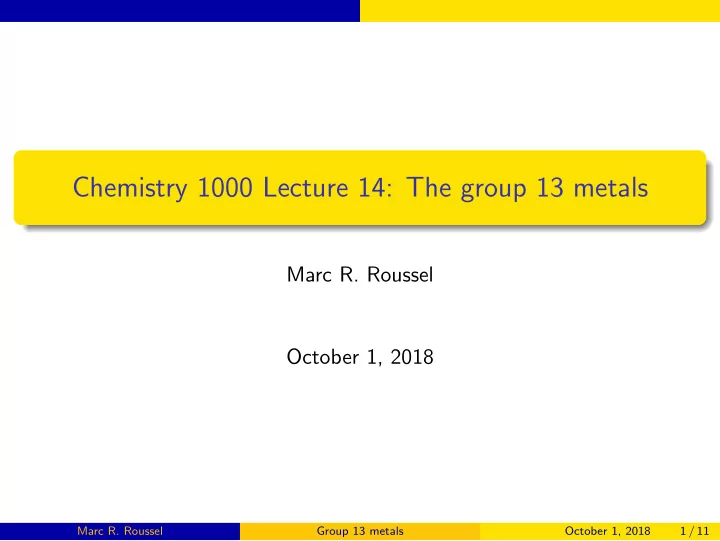

Chemistry 1000 Lecture 14: The group 13 metals Marc R. Roussel October 1, 2018 Marc R. Roussel Group 13 metals October 1, 2018 1 / 11
The group 13 metals All the elements in group 13 except boron are metals. Common ions: Al 3+ , Ga 3+ , In + , Tl + , also sometimes In 3+ and Tl 3+ Under typical reactions, these metals don’t react with water. At room temperature, the oxide formed is M 2 O 3 . Al(OH) 3 , Ga(OH) 3 and In(OH) 3 are all insoluble in water, but TlOH is very soluble. Aluminium is a good reducing agent ( E ◦ Al 3+ / Al = − 1 . 662). Marc R. Roussel Group 13 metals October 1, 2018 2 / 11
Thallium Thallium has many compounds of its +1 ion. Tl + and K + are very similar in size: 164 and 152 pm, respectively. In the body, Tl + can go wherever K + can go, which is pretty much everywhere. Most thallium compounds are toxic. Tl 2 SO 4 was once used as a rat and ant poison. Thallium(I) sulfate is tasteless, so it was once a popular poison, nicknamed “inheritance powder”. Unlike K + , Tl + reacts with sulfur ligands, disrupting proteins containing cysteine in particular. Marc R. Roussel Group 13 metals October 1, 2018 3 / 11
Passivation of aluminium Like Be, Al is passivated by an oxide layer which forms extremely rapidly when the metal is exposed to air. Aluminium oxide is hard (Mohs hardness 9, just below diamond) has a high melting point (2072 ◦ C) is non-porous Marc R. Roussel Group 13 metals October 1, 2018 4 / 11
Anodization of aluminium Deliberate, electrolytic thickening of the oxide layer: 2Al (s) + 3H 2 O (l) → Al 2 O 3(s) + 6H + (aq) + 6e − Has the following effects: Makes Al more chemically resistant Makes Al harder May be used to pigment the oxide layer with appropriate additives Marc R. Roussel Group 13 metals October 1, 2018 5 / 11
Acid-base properties of Al 2 O 3 Al 2 O 3 is amphoteric. Reaction with acid: Al 2 O 3(s) + 6H + (aq) → 2Al 3+ (aq) + 3H 2 O (l) Reaction with base: Al 2 O 3(s) + 2OH − (aq) + 3H 2 O (l) → 2[Al(OH) 4 ] − (aq) Marc R. Roussel Group 13 metals October 1, 2018 6 / 11
Reactions of Al with acids HNO 3 is an oxidizing acid because it typically attacks metals through the reduction of NO − 3 : 3 + 4H + + 3e − → NO + 2H 2 O NO − For Al, this reaction, just tends to make the oxide layer thicker, i.e. makes the metal more passive: 3 + 2H + → Al 2 O 3(s) + 2NO (g) + H 2 O (l) 2Al (s) + 2NO − Al reacts with non-oxidizing acids (e.g. HCl) in the typical way for a metal: (aq) + 3 Al (s) + 3H + (aq) → Al 3+ 2H 2(g) Why does this work despite the passivation layer? Marc R. Roussel Group 13 metals October 1, 2018 7 / 11
Reaction of Al with base Aluminium metal can be oxidized in aqueous base: (aq) + 3 Al (s) + OH − (aq) + 3H 2 O (l) → [Al(OH) 4 ] − 2H 2(g) Aluminium can react with acid or base, so it is amphoteric. Marc R. Roussel Group 13 metals October 1, 2018 8 / 11
Acid-base properties of Al(OH) 3 Al(OH) 3 is amphoteric. Reaction with acid (typical for metal hydroxides): Al(OH) 3(s) + 3H 3 O + (aq) → [Al(H 2 O) 6 ] 3+ (aq) Reaction with base (unusual for a metal hydroxide): Al(OH) 3(s) + OH − (aq) → [Al(OH) 4 ] − (aq) Marc R. Roussel Group 13 metals October 1, 2018 9 / 11
Production of aluminium Aluminium ore (bauxite) contains Al 2 O 3 , AlO(OH) and Fe 2 O 3 (among other things). Al 2 O 3 and AlO(OH) dissolve in base, but Fe 2 O 3 doesn’t: Al 2 O 3(s) + 2OH − (aq) + 3H 2 O (l) → 2[Al(OH) 4 ] − (aq) AlO(OH) (s) + OH − (aq) + H 2 O (l) → [Al(OH) 4 ] − (aq) Filter off solid Fe 2 O 3 , then precipitate Al(OH) 3 : (aq) + H 3 O + [Al(OH) 4 ] − (aq) → Al(OH) 3(s) + 2H 2 O (l) (There are other ways to precipitate out the hydroxide.) Recover aluminium oxide by heating: 2Al(OH) 3(s) + heat → Al 2 O 3(s) + 3H 2 O (g) Marc R. Roussel Group 13 metals October 1, 2018 10 / 11
Production of aluminium (continued) Al 2 O 3 has a very high melting point (2072 ◦ C). A 15:85 mixture of Al 2 O 3 and cryolite (Na 3 AlF 6 ) has a melting point of about 1000 ◦ C. This molten mixture is electrolyzed using a graphite anode: Anode: C (s) + 2O 2 − (l) → CO 2(g) + 4e − Cathode: Al 3+ (l) + 3e − → Al (l) Overall: 3C (s) + 6O 2 − (l) + 4Al 3+ (l) → 4Al (l) + 3CO 2(g) Liquid aluminium is denser than the ionic liquid from which it is electrolyzed, so it is collected from the bottom of the electrolysis vat. Marc R. Roussel Group 13 metals October 1, 2018 11 / 11
Recommend
More recommend